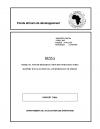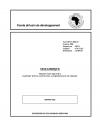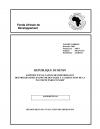
This review of Bank assistance to the social sector in Cameroon covers the 1996-2004 period. The review seeks to evaluate the Bank’s products and services, which involves an analysis of the main elements of the Bank’s assistance programme, namely the CSPs, lending operations and non-lending assistance, including sector studies and aid coordination. The evaluation also covers the outputs of Bank assistance to the social sector and its contribution to the development of Cameroon. It also examines the impact of the outputs on cross-cutting issues, namely: gender, the environment, regional integration, the private sector and community participation. Lastly, the contribution of various partners to the outputs of the Bank’s assistance programme is also evaluated.

At appraisal, the project components were selected from an inventory of all the destruction caused by the “El Nino” which had been prepared by the relevant government ministries with the assistance of the affected communities and United Nations agencies in Kenya. The key priorities were – reversal of life threatening situations; restoration of essential human services; restoration of vital economic functions and of life-line roads to cut off areas; and the protection of economic assets at risk. The project had four physical and one institutional component. The physical components were i) provision of chemicals, ii) the replacement of components in the national water resources monitoring network, iii) replacement and repair of components and machinery on the water supply system, and iv) the repair of 74 different category of roads. The fifth component was for consultancy services for the final designs, supervision of works, and technical, financial and management audits. See Annex 1

This Project Performance Evaluation is aimed at assessing the relevance, efficacy and efficiency of the Bank's lending activities and the effectiveness of the project financed. It is the result of an independent assessment of the specific action taken by the Bank Group. This includes an objective statement of the outcomes and results achieved by the project compared with expectations at appraisal; a critique of these expectations in the light of that comparison; an evaluation of how the Bank could have been more helpful and ajudgement whether in retrospect the project has achieved its objectives or is likely to achieve them and the outcomes or results achieved are sustainable or likely to be sustainable.

The Bank Group assistance in the public utility sector in Ethiopia commenced in 1975. The scope of the review covered all operations since then to 2004. The review is based on available documents and on findings of a field mission. The review was segmented into two periods: those financed up to 1995 in the pre-CSP period and those financed during the CSP era beginning 1996. The three CSPs covered the periods 1996-1998, 1999-2001 and 2002-2004. The review applied the standard evaluation benchmarks: Relevance, Efficacy, Efficiency of Implementation, Institutional Development Impact and Sustainability. The “with and without” evaluation approach was applied for the completed projects to situate the counterfactual related to the Bank’s assistance in the sector. This review is carried out at sector and project levels, the latter to make up for the lack of PCRs for many of the completed projects. The review also covers performance in nonlending activities and assesses the outcome of the interventions on major crosscutting issues. The performance of the Borrower/executing agencies and the Bank is also assessed to draw lessons of experience.

The present performance evaluation report relates to the budgetary reform support programme (BRSP) and the poverty reduction strategy support programme (PRSSP).

Tunis has gone from the stage of a country essentially dependent on primary product exports (hydrocarbons, phosphate, agricultural products) at the start of the ‘80s, to one deriving its resources from manufactured product exports and services. To do so, it firstly focused on the export of textiles, electrical and mechanical equipment, and food industry, tourism (and related activities) and agricultur al produce (olives, grain and wines).